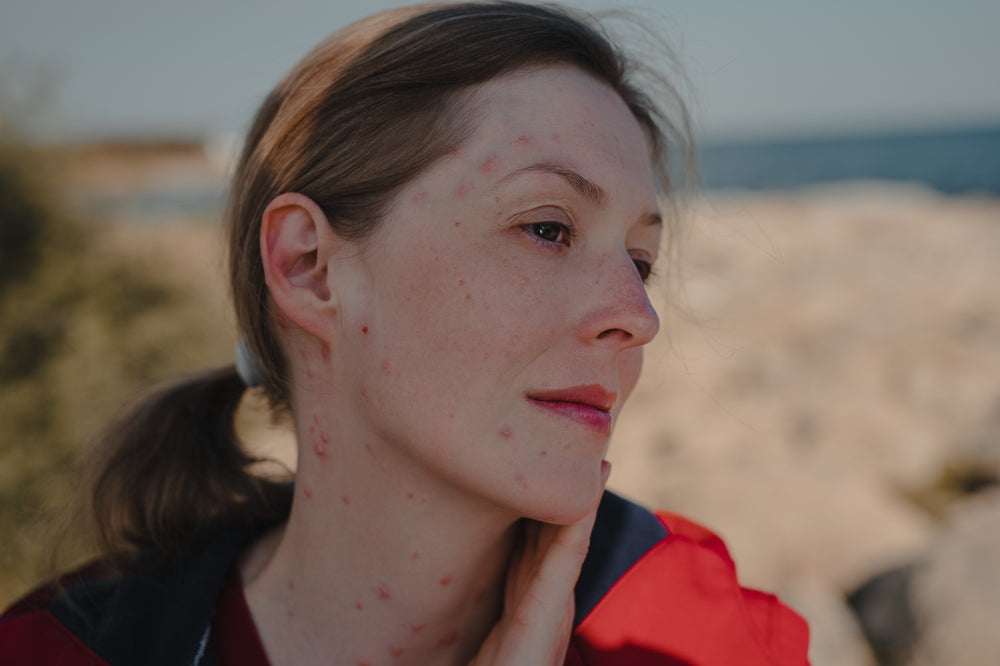Free U.S. Shipping On Orders Over $150

What Acne on Different Parts of Your Face Means: Acne Face Mapping
Posted on
While acne can occur anywhere on your face, specific types of acne tend to occur on the same areas every time. So in many cases, you can figure out what’s causing your breakout depending on where it occurs. This is called acne face mapping.
Here’s a quick guide to what acne on different parts of your face means.
Tip: You can also do the same for body acne. Here’s a guide to acne body mapping that we wrote sometime back.
Common Acne Locations and Their Causes
Acne on Hairline and Temples
Let’s start from the top. If you frequently get pimples around your hairline and temples, the most likely cause is your hair. Hair that’s in contact with the skin can trap oils, dirt and sweat, which then clog your skin pores and cause a breakout.
The hair products you use can also transfer onto your skin along the hairline and temples, causing acne breakouts.
To prevent this type of acne, ensure oily hair products don’t come into contact with your face. Using a cleanser on your face at least twice a day also prevents a build up of dirt and products in your pores.
T-Zone Acne

The T-zone includes the forehead, nose and chin. In teenagers, acne on the T-zone is typically hormonal. In adults, however, T-zone acne is indicative of oily skin.
People who produce too much sebum tend to develop pimples in their T-zone area. This happens when sebum mixes with dead skin cells and clogs pores. Sweat, dirt and certain skin products can worsen the clogging, increasing the risk and severity of T-zone acne.
The best way to deal with T-zone acne is adopting a skin care routine and skin products designed for oily skin. Use a cleanser and toner at least twice a day, use non-comedogenic products, moisturize regularly and exfoliate your face 2-3 times a week.
Even your makeup products should be lightweight, non-oily and formulated for oily skin.
Forehead-only Acne
If your breakouts appear only on your forehead and not the entire T-zone, that likely points to a different cause other than oily skin.
Hair-related acne can spread down from your hairline to your forehead. If you have pimples along your hairline as well as your forehead, your hair is the issue.
Stress can also cause an acne breakout on just your forehead. Stress acne usually appears as small pimples or white heads.
Acne on Cheeks
In most cases, acne on cheeks is mechanical, or what’s called acne mechanica. This is a type of acne caused by friction and pressure.
Constantly rubbing your face, wearing a mask or resting your cheek on your hand can lead to acne mechanica.
Acne on cheeks can also be caused by contact with unclean surfaces, usually your hand. Your hands pick up a lot of dirt, bacteria, oils and other stuff from the many surfaces you touch. When you touch your face, you transfer them onto your skin where they can cause or worsen acne.
Your phone can also cause acne on your cheek because of the unsanitary screen. In this case, you will notice that the breakout happens mostly on the side that you hold your phone against.
Your pillow can also cause cheek breakouts if you don't change your pillowcase often enough (2-3 times a week).
To prevent acne on your cheeks, avoid touching your face, change your pillowcase regularly and use your phone on loudspeaker or with headphones.
If you wear a mask daily, get a comfortable skin-friendly mask. We recommend the Hercleon Aplu mask. It is an antibacterial mask designed specifically to prevent mask-caused acne on your face.
Jawline and Chin Acne

Acne along the jawline and acne is most common in women. That’s because it’s usually hormonal. Fluctuations in hormones during the menstrual cycle, pregnancy and menopause increases the risk of a breakout on your lower face.
Taking good care of your skin can reduce the risk and intensity of jawline and chin acne: moisturize, exfoliate, cleanse and use the right products for your skin type.
If your hormonal acne is really bad, use over the counter or prescription acne medication to fight the breakout. It’s also a good idea to talk to a doctor just in case the breakouts are a signal of an underlying hormonal health problem.
Acne Around Your Ears
It is unusual, but you can get acne around and behind your ears. The most common culprit is your hair.
If you have hair hanging down to your ears, it’s probably trapping sweat, dirt and oils against your skin. Any hair products could also be transferring onto your skin and clogging pores.
Taking good care of your skin, including the often forgotten areas around your ears, can help prevent these kinds of breakouts. But if the acne is persistent, consider changing your hair products. If that still doesn't work, your only option might be cutting your hair shorter or finding a different hair style.
Quick links
Contact
6063 Hudson Road #160
Woodbury, MN 55125
Yo@hercLeon.com
Leave a comment: